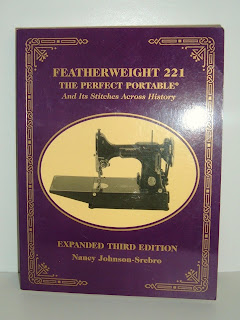Like many quilters, I am fascinated by the vintage Singer Featherweight 221 sewing machine, a superbly engineered little machine that has become a true collector's item. My generous Uncle Bill surprised me with one a year ago.
Nancy Johnson-Srebro's book, Featherweight 221: The Perfect Portable and Its Stitches Across History (3d ed. 2001), a 220-page tome published by C&T Publishing, Inc. (www.ctpub.com), provides a wealth of information on the history of these classic portable sewing machines (ISBN 0-9645469-2-2).
The machines weigh only 5.0 kg (11 pounds, 1 ounce), and fit into an ingeniously designed carrying case. Most featherweights are black with a shiny japan finish, and decorative gold decal designs, although some beige and white machines were also made. The decal on my machine is the "Prism" design, which has an art deco look. Although the machine has only a straight stitch, there are a number of attachments including a hemmer, binder, edge-stitcher, gatherer and ruffler, designed to entice the home sewer.
The rotary hook machines were manufactured from approximately 1933 until 1961 in Elizabethport, New Jersey. Other machines were made at the Clydebank factory in Glasgow, Scotland. Some of the British machines had motors manufactured in St. Johns, Quebec, Canada. Special commemorative editions were made for the Century of Progress International Exposition (the 1933-1934 Chicago World's Fair), and the 1936 Texas Centennial Exposition. The gold-colored oval medallions with these inscriptions are true finds!
The 1933-1934 Chicago World's Fair could warrant another entire post. Merikay Waldvogel and Barbara Brackman, two venerable quilt historians, teamed up to write Patchwork Souvenirs of the 1933 World's Fair (1993). Their book offers a pictorial and historical account of the scandalous quilt contest sponsored by Sears Roebuck during the Depression. http://www.amazon.com/Patchwork-Souvenirs-1933-Worlds-Fair/dp/1558532579. I had the pleasure to hear Merikay Waldvogel's lecture on that topic, sponsored by the Nebraska Humanities Council, a few years ago.
For now, I'll put my shiny black gem back in its case.
TTFN
LeAnn aka pasqueflower
http://pasqueflowerponderings.blogspot.com
http://www.etsy.com/shop/pasqueflower
Twitter@lfrobom





That is a cute little machine! Does your still work?
ReplyDeleteAren't older sewing machines just fascinating? I remember my grandmother's machine with the big plate underneath to put your foot on and make it go.
ReplyDeleteWhat a cute little sewing machine! I remember playing with my grandmother's machine she had in her baement. It had a foot petal. I don't remember if it actually worked. I just liked pretending.
ReplyDeleteGreat post!
My grandmother had an old, old Singer. I never learned how to use it, but I still thought it was beautiful.
ReplyDelete